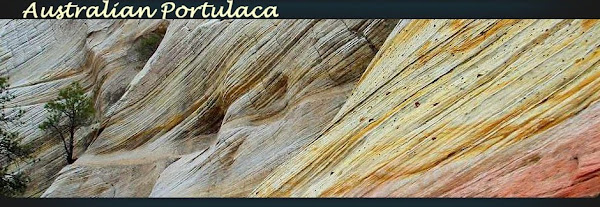P. intraterranea differs from P. oleracea by the following characters:
- flowers in 3-4 flowered heads (cf. 2-30 for P. oleracea),
- significantly larger petals (10-17 mm long, cf. 4-7 mm for P. oleracea),
- petals twice as long as the sepals (cf. scarsely longer than the sepals for P. oleracea),
- greater number of stamens (more than 20 for P. intraterranea, cf. less than 20 for P. oleracea),
- a generally stouter growth habit (cf. sprawling and spreading habit for P. oleracea).
In taxonomic illustrations, P. intraterranea is often shown with cuneate-oblanceolate ("wedge-shaped") leaves while P. oleracea tends to have distinctly obovate leaves. However this appears to be only a general rule.
The seed is distinctly comma-shaped, grey-black in colour, sometimes shiny (or iridescent). The testa cells are basally stellate and forming prominent tubercles in ornate, concentric rows which are nippled or pointed. PlantNET illustrates these characters well.
By comparison, the seed of P. oleracea is shiny black and more rounded in outline. The testa is only minutely tuberculate, the concentric rows are less distinct, and the testa cells are rarely pointed but more often rounded.
Some authors claim that P. intraterranea has a distinct taproot, but other authors do not mention this. It would also appear from the literature that there are both annual and perennial forms.
As is the case with P. oleracea, the species P. intraterranea is morphologically variable over its range of distribution. Some of the variants may prove to be distinct taxa.
Indeterminate taxa are often encountered on inland sand or clay plains. One has quite small, oblong leaves, a compact growth habit, flowers 8-12 mm and a stamen count of 10-20. It looks like a larger-flowered form of P. oleracea. Yet it is recognizable by sight and may even co-habit areas with more typical forms of P. oleracea. Other forms are indistinguishable from P. oleracea, apart from the much larger flowers. Many of these plants appear to fit broadly into a pan-Pacific P. lutea clade, which includes P. howellii D. Legrand from the Galapagos Islands.
The author Attila Kapitany has kindly sent me a CD of his photographs of P. oleracea and other species. Some of the species were photographed in habitat, others were grown from seed in his Melbourne garden. I have tried, but in many cases failed, to sort the photographs in the "Oleracea" folder into identifiable species. I will include some of the photographs here. One plant shows a flower with 20+ stamens, but the rest of the flowers on the same plant barely have 10 stamens. Yet the flowers are noticeably larger than typical forms of P. oleracea. I am sure that Australian herbaria must be full of specimens like these. In some cases botanists may have made a "best judgement" based on the available characters. In other cases the specimens may have been deemed indeterminate. It is possible that seed may go some way towards providing a positive identification in these cases.
Here are some of the photos. You be the judge!
I am constantly surprised by the apparent lack of interest in P. intraterranea in Australia. The species is described in dry, technical terms in official and scientific literature, but has been largely ignored by horticultural journals. Equally surprising is the chronic lack of photographs of the species! The few that I have found online appear to be either misidentifications of P. oleracea or are one of the "indeterminate" forms mentioned in the previous two paragraphs.
The species has clear horticultural potential, yet it would appear that no work has been undertaken with a view to producing select cultivars. The outcrossing of selected cultivars, especially perennial forms, may produce larger-flowered clones with increased vigour. There is scope to produce plants of equal callibre to the exotic P. umbraticola and P. grandiflora cultivars that are so commonly grown in summer gardens in Australia.
This species clearly deserves more attention from both science and horticulture.


.jpg)












No comments:
Post a Comment